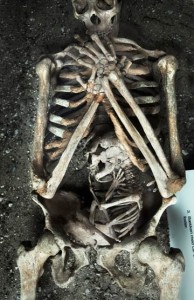In 1982, the beaches of Herculaneum began to be excavated. Over 250 skeletons were found on the beach and in a boat shed (Capasso, 2000). The bones that were left behind were exposed to relatively low temperatures and force allowing the good preservation in structure and special relation to each other (Scaravilli, 2002). This unique paleobiological data on composition of the population, their habits, and occupations could provide a valuable opportunity to learn about an ancient Roman population (Mastrolorenzo, 2001; Scaravilli, 2002). Some of the most interesting finds are:
- A 25-year-old pregnant woman was found on beach; she was known to be pregnant because of tiny fetus bones (Capasso, 1998)
- The women, along with many other individuals were determined to have lice because 22% of the skulls found showed signs of supra-inion depression. This is caused from scratching (not a surprise to find lice infestation in ancient Rome when prominent individuals of the time had died from infestation) (Capasso, 1998)
- The first surge caused instant death, due to no sign of mechanical impact, self-protection reaction, or agony contortions. Indicating vital organs stopped before the brain could react and cause defensive reactions (Mastrolorenzo, 2001)
- Some had articulated fractures that were common when looking at incinerated bodies (Mastrolorenzo, 2001)
- The skeletal remains also showed a demographic drop off in younger children in the population, leading them to believe that the earthquake of 62 AD had a high mortality rate for children born between the years of 58 AD and 63 AD (Capasso, 1999)
- One practical application is the development of hazard evacuation plans with actions aimed to reduce the risk in loss of life at Vesuvius and other violently active volcanoes (Mastrolorenzo, 2010).
Next: The “Ringed” Lady



